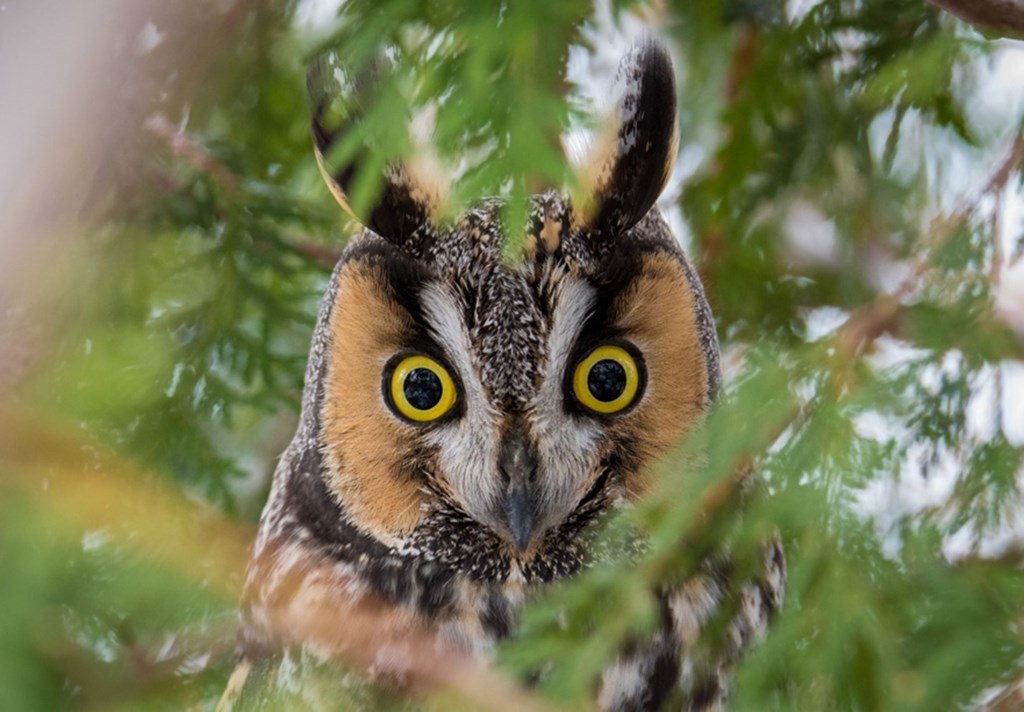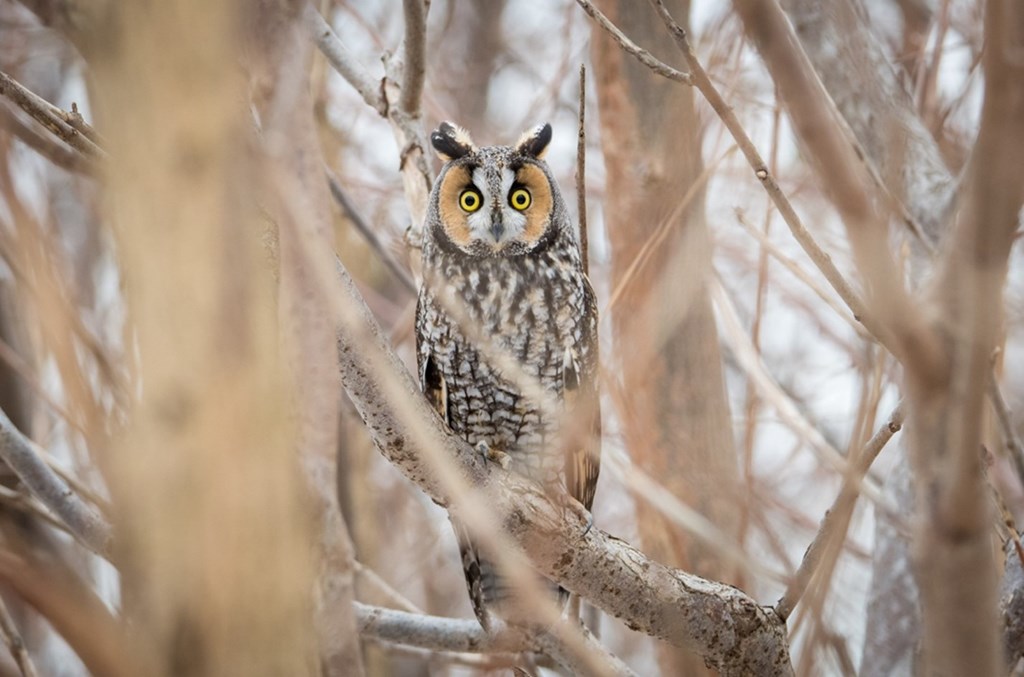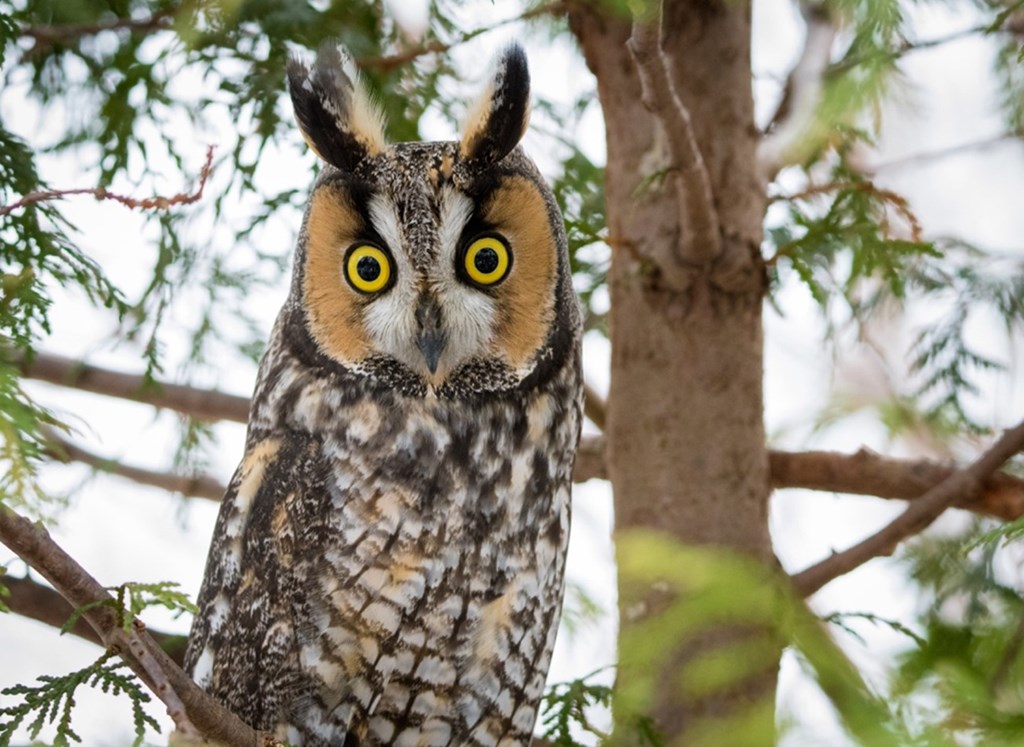Long-eared Owl
Asio otus

Name
The Genus name Asio is Latin for “a horned owl," and the species name otus means the same, in Greek. The common name reflects this owl’s relatively long ear tufts.
General Description
Long-eared owls have an elongated appearance compared to their closest look-alikes, the short-eared owl and the great-horned owl. Long-eared owls erect their ear tufts when camouflaging with forest vegetation, yet when in flight their head appears round. They have yellow eyes, black beaks, and rufous facial disks. Their wrist markings are more subtly contrasted with their underwings than short-eared owls, and they appear darker overall. Females have heavier streaking than males.
Similar species: The difference in appearance of long-eared owls to short-eared owls is mentioned above. Compared to great-horned owls, long-eared owls are lanky, with slimmer ear tufts and a more rufous facial disk. Their flight is lighter, more closely resembling that of other meadow-dwellers with a buoyant and moth-like wingbeat.
Fun Facts
• To camouflage, long-eared owls will “suck in,” use their wings to cover the conspicuous patterning on their flanks and erect their ear tufts.
• A male’s hoot can be heard up to 1 kilometer away (0.7 miles).
• Long-eared owls will sometimes form communal winter roosts of up to 100 birds, with occasional short-eared owl visitors mixed in.
• Parents have been known to feign injuries to protect their young, a behavior seen in some ground-nesting birds such as short-eared owls and shorebirds.
Size
| Females | Males | |
| Wingspan | 35-40 cm (14-16 in.) 5 pencils end-to-end ✏️✏️✏️✏️✏️ | Same |
| Mass | 383 g (13.5 oz) 🍋🍋🍋 Slightly over 3 lemons | 315 g (11.1 oz) 🍋🍋🍋 Nearly 3 lemons |
Vocals
Long-eared hoots can be heard primarily in the pre-breeding season. Males give a series of low hoots before courtship displays, and at times both sexes may duet together, the female’s call sounding more like a lamb than a hoot. Hungry juveniles give frequent begging screeches that carry far distances and sound similar to a squeaky wheel. Given this species’ effective camouflage and nocturnal behavior, listening to these begging calls in late spring has become one of the best ways to survey for their presence. Long-eared owls clap their wings like short-eared owls, yet they use this behavior under a wider set of circumstances; in addition to courtship, clapping is used in threat displays and in response to danger near the nest.

Habitat
Long-eared owls are closely tied to dense forests and forest edges. They seek out areas with canopy protection for roosting (often communally) and nesting, with nearby open space for hunting. Such multidimensional habitats include Rocky Mountain spruce forests, isolated woodlots within prairies, mixed conifer-hardwood patches in New England, riparian corridors in the Southwest, and old growth forests of the Pacific Northwest. Long-eared owls exhibit high roost fidelity (returning to the same roost site year after year), even to individual trees. Long-eared owls rely upon abandoned nests of crows, ravens, and hawks for their own nest sites, adding an interesting element to their breeding territory requirements.
Feeding
Long-eared owls are small-mammal specialists, with voles and mice comprising the bulk of their diet; meadow voles alone make up a quarter of the diet for some individuals assessed in North America. Exact species composition is dependent on geographical location and time of year, as with other owls. For example, in Kansas long-eared owls hunting in grasslands feed upon deer mice, harvest mice, and prairie voles yet owls in urban areas feed primarily on cotton rats. Long-eared owls in Idaho switch between several types of small mammals across seasons. Throughout their range, long-eared owls seem to care more about the size of their mammal prey than which species it is. Birds are occasionally eaten; however, this seems to be more common in Europe.
Individual adults require approximately 1 to 3 small mammals per day. Hunting behavior consist of coursing over open ground less than a meter (3’ 3’’) above the vegetation until prey is located, at which time the owl drops to pin its victim. They are nocturnal hunters, though exceptions occur; breeding birds may hunt during the day in order to provide enough prey for their growing young, and individuals at high latitudes are faced with very few nighttime hours therefore they must hunt in light. Long-eared owls possess asymmetrical ears openings, allowing them to pinpoint the location of prey with an efficiency that is not afforded to all owls.
Nesting
Long-eared owls become sexually mature in their first year of life. Courtship typically begins in March, during which males perform flight displays from dusk to dawn over prospective nest sites. While in flight, they clap their wings up to 20 times, yet singly rather than in quick succession like the short-eared owl. During displays, females may give their braying “nest” call. Once a pair has bonded, they begin roosting near each other, and the female chooses a nest location which doubles as the site for copulations with her new mate. Contrary to lifelong monogamous raptor species, researchers suspect that long-eared owls form new pair bonds every season.
Long-eared owls seek out sturdy and inconspicuous platforms for their nests, typically reusing the stick nest of squirrels, hawks, and especially corvids (crows, ravens, magpies). Eggs are laid between March and May, with an average clutch size of 4.5 eggs. Incubation lasts for 25-30 days and is completed by the female while the male provides food, which he continues to do after the eggs hatch. Nestlings begin branching and exploring their surroundings after 20-26 days of age, and fledging occurs after 30-40 days. When all is said and done, the owlets achieve independence just 8 to 11 weeks after hatching.
Breeding density of long-eared owls is low, meaning there are relatively few pairs per unit of space, underscoring the importance of protecting forest edge habitats within this species’ range. Nesting success of long-eared owls has been studied more intensively in Europe than in the Western Hemisphere, where 48-57% of observed nests successfully fledge young. Nest failures were often attributed to raccoon predation, though in North America, nest predation has been scantly studied.
The density, timing, and success of long-eared owls breeding in North America is likely linked to the availability of small mammals, though more research is needed on this species to confirm trends.
Migration
Long-eared owls are seemingly nomadic, though their movements are likely linked to the availability of prey. The presence or absence of voles serves as a predictor for long-eared owl presence or absence. However, in terms of understanding patterns such as directionality and precise timing, we are a long way off from certainty. We do know that some long-eared owls migrate, and from netting data in the Great-Lakes region, researchers have learned that juveniles migrate earlier than adults. Long-eared owls have demonstrated puzzling movements such as northward trends and high individual variability in how far they will fly, making their movement ecology a well-kept secret. For now.

Current Conservation Status
Long-eared owls are difficult to monitor given their nomadism and elusive behavior, and therefore conclusions about their status are best viewed as incentives for habitat protection, not definitive representations of how the species is faring. The IUCN deems long-eared owls as a Species of Least Concern with a global downward trend. Here in Pennsylvania, long-eared owls are listed as threatened. Christmas bird counts across the United States have provided evidence of decline. The populations in Canada and Mexico seem to be doing well, and the species has not been listed as a species of concern in either country, however this may be a consequence of information gaps.
The primary threat to long-eared owls is habitat loss, and although they can thrive in fragmented forests, they need access to open landscapes in addition to treed areas. In California, riparian areas in the Central Valley are a fraction of what they used to be, and in the Northeast many open meadows have been reforested; these habitat reallocations are examples of actions that can negatively affect long-eared owls.
The specific effects of rodenticides and West Nile Virus on long-eared owls are unknown, however they likely depress health in ways similar to other raptors; ingestion of rodenticide causes internal bleeding and West Nile Virus can compromise body condition and reproductive success.
As rodent specialists, long-eared owls are valuable members of a healthy ecosystem and, as is true, for all raptors, they are bioindicators. This means they offer us a bar with which to measure the health of the environment. If long-eared owls are thriving, there must thus be a healthy ecosystem supporting them. It’s all connected, and long-eared owls are a part of the web.
How can you help long-eared owls?
If you are a landowner, you can help long-eared owls by welcoming them as pest managers. This means that instead of relying on rodenticides, which are extremely harmful to raptors, you and your community can support habitat features that attract long-eared owls and through these actions, increase the rodent control on your land. Encouraging rotating crop cycles, creating edge habitats, halting the use of rodenticides, and supporting long-eared owl research are just some of the potent ways you can help these beautiful birds. There are also cash incentives for landowners that support wildlife improvement areas through a project called the Conservation Reserve Enhancement Program (CREP). To learn more about these potential actions click here and/or contact Dr. Laurie Goodrich, the Sarkis Acopian Director of Conservation Science at Hawk Mountain: [email protected].
Long-eared owls will use artificial nest platforms, a supplemental resource which has not yet been heavily experimented with. If you are a landowner and believe you may have adequate habitat to attract long-eared owls, feel free to contact Dr. JF Therrien, our Senior Scientist ([email protected]). Together, we may be able to attract more long-eared owls to suitable habitat.
If you are not a landowner, you can still help long-eared owls by spreading the word and encouraging your community to protect and cultivate tracts of healthy open habitat, riparian areas, and/or erect artificial platforms. You can also help by supporting research, an imperative step if we are to learn more about this species. For example, researchers have recently tried a new method of surveying long-eared owls by focusing survey efforts to the early nesting season and listening for the loud begging calls of nestlings, instead of focusing on adult hooting. This is a promising protocol that may result in more realistic population estimates on breeding grounds. We have the method, now we just need the money to send surveyors into the field.
Special thanks to Jamie Lehn for her generous photo contributions to this account.
Information written and compiled by Zoey Greenberg.
Sources
BirdLife International 2018. Asio otus . The IUCN Red List of Threatened Species 2018: e.T22689507A131922722. https://dx.doi.org/10.2305/IUCN.UK.2018-2.RLTS.T22689507A131922722.en. Downloaded on 30 January 2020.
Bull, E., Wright, A., & Henjum, M. (1989). Nesting and Diet of Long-Eared Owls in Conifer Forests, Oregon. The Condor, 91(4), 908-912. DOI: 10.2307/1368075
Cornell Lab of Ornithology. (2019). All About Birds: Long-eared Owl. Retrieved from
https://www.allaboutbirds.org/guide/Long-eared_Owl/overview
Davorin Tome (2011) Post‐fledging survival and dynamics of dispersal in Long‐eared Owls Asio otus,Bird Study, 58:2, 193-199, DOI: 10.1080/00063657.2011.559531
Johnsgard, P. A. (1988). North American owls: biology and natural history. Washington, D.C.: Smithsonian Institution Press.